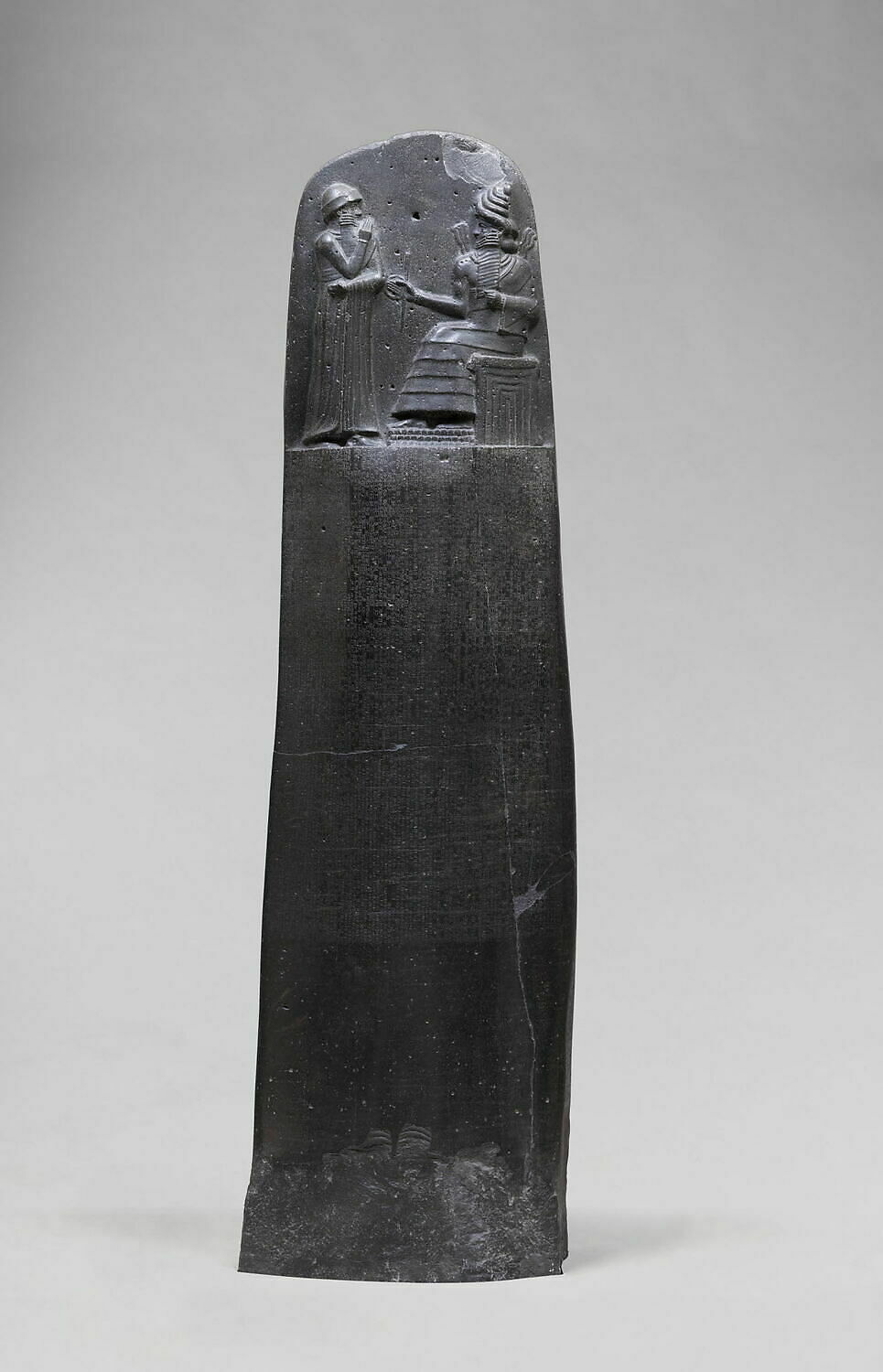Law is at the heart of modern civilization, and is often based on principles listed here from nearly 4,000 years ago.
Law Code Stele of King Hammurabi, basalt, Babylonian, 1792–1750 B.C.E. (Musée du Louvre, Paris)

Law Code Stele of King Hammurabi, basalt, Babylonian, 1792–1750 B.C.E. (Musée du Louvre, Paris)
Hammurabi of the city-state of Babylon conquered much of northern and western Mesopotamia and, by 1776 B.C.E., he was the most far-reaching leader of Mesopotamian history, describing himself as “the king who made the four quarters of the earth obedient.” Documents show Hammurabi was a classic micro-manager, concerned with all aspects of his rule, and this is seen in his famous legal code, which survives in partial copies on this stele in the Louvre and on clay tablets. We can also view this as a monument presenting Hammurabi as an exemplary king of justice.
What is interesting about the representation of Hammurabi on the legal code stele is that he is seen as receiving the laws from the god Shamash, who is seated, complete with thunderbolts coming from his shoulders. The emphasis here is Hammurabi’s role as pious theocrat, and that the laws themselves come from the god.
Additional resources
Read an English translation of the Code of Hammurabi on Yale’s ‘The Avalon Project.’
Learn more about record keeping with clay tablets.
Read a chapter in our textbook, Reframing Art History, about rethinking how we approach the art of the Ancient Near East.
Smarthistory images for teaching and learning:
[flickr_tags user_id=”82032880@N00″ tags=”hammurabi17,”]
[0:00] [music]
Dr. Steven Zucker: [0:05] We’re in the Louvre in Paris, looking at one of their most famous objects. This is the law code stele of King Hammurabi.
Dr. Beth Harris: [0:13] It’s interesting to me that this is one of the most popular objects to look at here, and I think it’s because of our modern interest and reliance on law as the founding principles of a civilization. And this is such an ancient object. This is nearly 4,000 years old.
Dr. Zucker: [0:28] A stele is a tall carved object. This one is carved in relief at the top and then below that and on all sides we have inscribed cuneiform. It’s written in the language of Akkadian.
Dr. Harris: [0:39] Which was used for official government decrees.
Dr. Zucker: [0:42] That’s the language. The script is cuneiform. It’s divided into three parts. There’s a prologue, which talks about the scene that’s being represented at the top, the investiture of Hammurabi. What we see is the king on the left. He’s smaller, and he’s facing the god, Shamash. This is the sun god, the god of justice.
Dr. Harris: [1:01] We can tell he’s a god because of the special horned crown that he wears and the flames or light that emanate from his shoulders.
Dr. Zucker: [1:08] We can think of this as a kind of divine light; [similar to] the way that in so much Christian imagery, we see a halo.
Dr. Harris: [1:13] We have that composite view that we often see in ancient Egyptian and ancient Near Eastern art where the shoulders are frontal, but the face is represented in profile.
Dr. Zucker: [1:21] Shamash sits on a throne. If you look closely, you can see under his feet the representation of mountains that he rises from each day. He’s giving to the king a scepter and a ring. These are signs of power.
Dr. Harris: [1:33] Hammurabi is demonstrating here that these are divine laws.
Dr. Zucker: [1:36] That his authority comes from Shamash.
Dr. Harris: [1:38] We have more than 300 laws here.
Dr. Zucker: [1:41] And they’re very particular. Scholars believe that they weren’t so much written by the king as listed from judgments that have already been meted out.
Dr. Harris: [1:49] They’re legal precedents, and they take the form of announcing an action and its consequences. If you do X, Y is the consequence.
Dr. Zucker: [1:58] For example, if a man builds a house, and the house falls on the owner, the builder is put to death.
Dr. Harris: [2:04] There’s a kind of equivalence. This might remind us of the Biblical law of “an eye for an eye” or “a tooth for a tooth.”
Dr. Zucker: [2:11] Which is also found on the stele, and it’s important and interesting to note that the stele predates that Biblical text.
[2:18] The last part of the text, what is often referred to as the epilogue, speaks to the posterity of the king, of the importance of his rule, and the idea that he will be remembered for all time.
Dr. Harris: [2:27] This is certainly not a unique stele in terms of recording laws, but it does survive largely intact. When it was discovered, it was broken only into three parts, which you can still see today.
Dr. Zucker: [2:38] These laws, almost 4,000 years old, tell us a tremendous amount about Babylonian culture, about what was important to them. So many of these laws deal with agricultural issues, issues of irrigation, and are clearly expressing points of tension in society.
Dr. Harris: [2:53] A lot of them have to do with family life, too. The king is, after all, responsible for the peace, prosperity, and feeding of his people.
Dr. Zucker: [3:02] The stele is such a wonderful reminder that Mesopotamia was such an advanced culture. Here, almost 4,000 years ago, we have cities that are dependent on good crop yields, that require laws to maintain civil society, and a reminder of the debt that the world owes to the ancient civilizations of Mesopotamia, an area that is seeing so much conflict now.
[3:23] [music]




